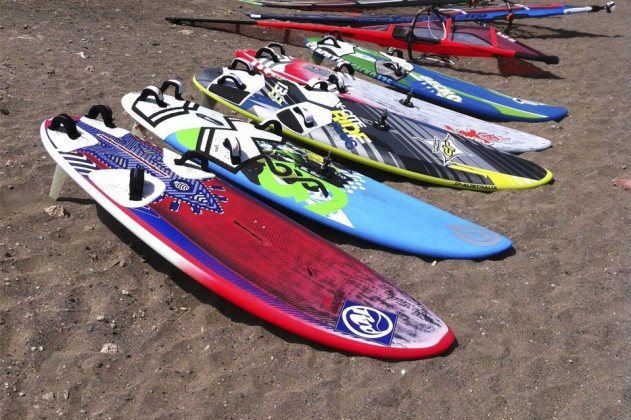SEABREEZE SIZZLERS
130L Freeride Board Test 2014
Summer brings us plentiful sea breezes, warm water and, hopefully, sunny weather – perfect for a blast or cruise on a fine and bright day.
With the winter wave boards tucked away, for now, in the garage, it’s time to make the most of moderate thermal wind and enjoy some gybing, blasting and the occasional carving move perhaps?
We took five of the current crop of 135L freeride offerings for a spin to see which might be best for the job.
This test was originally published in the July issue.
WHO ARE THEY FOR?
Perhaps you’re new to shortboarding? Working on getting in the straps and harness and attempting those first few gybes? Or maybe you’re a seasoned sailor looking for a lighter-wind fix? For sure, none of these boards will hold you back. But, are they the right pick? These ‘traditional’ freeride boards now have rivals from the up-and-coming wide-and-thin ‘freemove’ board movement. (See our test of 120L x 80-wide Freemoves in the April issue and on our website www.windsurf.co.uk)
PRINCIPAL TEST TEAM
James Randall 70 kg. Med. Height
Julian Da Vall 83 kg. 1.95 Tall. Experience national and European-level racer.
Tony Gibson 87kg 1.90 Tall
Brian McDowell 100 kg. 1.90 Tall.
Thanks also to Kevin Salmon 85kg & Kevin Pijl 70kg.
READ MORE 2014 EQUIPMENT TESTS
VERSUS NEW SKOOL ‘WIDE-STYLE’ FREEMOVE BOARDS
Freemoves offer many of the qualities of the traditional freeride hull and, in terms of rocker line, more or less, replace a Freestyle-Wave board of the same volume, but with added benefits of a larger board. (Float, early planing etc. – all with a smaller fin than a larger-volumed ‘traditional’ board of equivalent float/stability.) In discussion about freemoves, we’ve often spoken about ‘perceived volume’. That is, these shapes feel like a board 10-15L larger when off the plane – and 10-15L smaller when flying. They have plenty of stability and carve well so why would we want a traditional board? Well, as nice as the compact nature of the freemove is, entry-level riders in particular still need some degree of length to help them both on and off the plane. Plus the traditional boards are a lot less demanding of technique, namely ‘passive’ planing, whereas the freemoves often require a degree of ‘active’ technique to get them going. There are exceptions in both categories, but the length of the ‘normal’ freerider will still pay dividends when off the plane, tracking upwind, stability and early planing power. Luckily, in this selection we have some of both to achieve a good comparison, with the Fanatic Gecko – and to some extent the Starboard Carve – having the most modern freemove-style outlines in this bunch.
TRENDS – WHAT DID WE FIND?
Some of these boards offer improvers a ‘Fixed radius’ gybing arc, taking natural and almost pre-set radius for added security. These fixed turning circles are also possible at pretty low speeds for added forgiveness to intermediate gybers. The Fanatic Gecko offers this more than anything else in this bunch. Some are more demanding – yet exciting – and cater to a wider range of abilities. One or two offer the best of both worlds.
THINGS TO BEAR IN MIND ABOUT THE TESTING
• We’ve tested individual models, NOT ranges, so have an open mind if it’s other sizes of the products we review that you’re considering
• We mainly used these on 7.8 twin cams and 6.0 crossover sails
• All findings in these reports are relative to the selection we had on the beach at the time. So, for example, if a board isn’t listed as the best early planer or fastest, it doesn’t mean it’s a poorly performing board, just relative to the rest of the test selection in the conditions we had during the process
• A lot of these boards are in the most expensive constructions. Bear in mind the mid-range layups are only slightly heavier, arguably stronger – and most definitely better value for money. Also consider the ‘High resistance Skin’ (HRS) versions that are durable (but significantly heavier, although this isn’t a massive deal for improvers) and even better bang for your buck.
• We tried these shapes with fairly inboard straps as improvers might choose. For sure we could eek out more speed et cetera by fitting them further outboard but that would defeat the object.
WHICH ONE SHOULD YOU BUY?
Best Gybers: The RRD Firestorm, Starboard Carve, JP X-Cite Ride and the Fanatic Gecko. The RRD and Carve – and to some extent the JP – deliver a wider variety of arcs for more advanced gybers, while remaining soft and forgiving to improvers. The Gecko is best for first-time gybers but has a more set radius that might limit more advanced sailors.
Early Planing: The Starboard Carve by a country mile followed by the JPAustralia X-Cite Ride.
Fastest: Tough call. Comfort is everything, so probably the RRD, Starboard and JP followed closely by the Fanatic and Goya.
Which Ones Would We Buy? For us the benchmark is still the Carve, but the RRD is very close behind – and arguably best for more advanced sailors – with only the Starboard’s excellent early-planing ability making the difference. First-time gybers and improvers should give very careful consideration to – or go and demo – the Fanatic Gecko.
Now read the individual reports – happy shopping!
Special thanks to Tenerife Windsurf Solution (TWS) centre for hosting us – the best demo/hire centre in the world and I Love Meet and Greet Airport Valet Parking Services.
THE LINE-UP
JP AUSTRALIA X-CITE RIDE PLUS PRO EDITION 135


